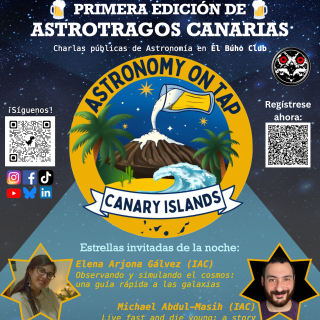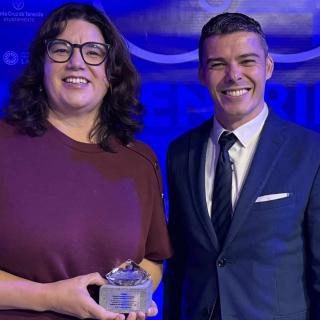Las primeras Jornadas de Puertas Abiertas en el Observatorio del Roque de los Muchachos (La Palma) correspondientes al año 2001, celebradas el pasado domingo, 15 de julio, y organizadas por el Instituto de Astrofísica de Canarias, atrajeron al Observatorio a 2.272 visitantes. Durante la jornada se pudieron visitar seis instalaciones distintas: el telescopio "William Herschel", el telescopio "Isaac Newton", el telescopio Nacional Galileo, el telescopio Nórdico Óptico, el telescopio "Mercator" y el experimento HEGRA. La organización contó con la colaboración de 48 personas, entre astrónomos de las distintas instituciones usuarias del Observatorio, personal propio de apoyo (administrativo, sanitario y de mantenimiento), además de diversas entidades como la agrupación de astrónomos aficionados "Isla de la Palma", AEA, Guardia Civil y Cruz Roja. Las visitas se realizaron en tres idiomas: español, inglés y alemán, y los 2.272 visitantes fueron divididos en 84 grupos distintos, cifras que superan considerablemente las de las jornadas celebradas el pasado año. La novedad en esta ocasión fue la posibilidad de visitar el telescopio "Mercator", el "benjamín" del Observatorio, que entró en funcionamiento el pasado mes de mayo. Se recuerda que las próximas Jornadas de Puertas Abiertas tendrán lugar el domingo 9 de septiembre.
Advertised on
It may interest you
-
 El Instituto de Astrofísica de Canarias (IAC) inaugura este miércoles 17 de diciembre una nueva edición del ciclo "Cosmoviaje 2.0. Lo que sabemos e ignoramos del Universo" y lo hará de la mano de la investigadora y directora del Museo de la Ciencia y el Cosmos Antonia Varela quien impartirá su charla " Observatorios de Canarias y sus descubrimientos" a las 16:15 horas. La entrada será libre y gratuita hasta llenar el aforo. Una experta de referencia en astrofísica y divulgación Antonia Varela es doctora en Astrofísica e investigadora del IAC, donde forma parte del Grupo de Calidad de Cielo yAdvertised on
El Instituto de Astrofísica de Canarias (IAC) inaugura este miércoles 17 de diciembre una nueva edición del ciclo "Cosmoviaje 2.0. Lo que sabemos e ignoramos del Universo" y lo hará de la mano de la investigadora y directora del Museo de la Ciencia y el Cosmos Antonia Varela quien impartirá su charla " Observatorios de Canarias y sus descubrimientos" a las 16:15 horas. La entrada será libre y gratuita hasta llenar el aforo. Una experta de referencia en astrofísica y divulgación Antonia Varela es doctora en Astrofísica e investigadora del IAC, donde forma parte del Grupo de Calidad de Cielo yAdvertised on -
 The Instituto de Astrofísica de Canarias (IAC) announces the arrival of the Astronomy on Tapinternational talk series in Spain, with its very first edition to be held in Tenerife. This outreach initiative, which was created in the United States and has since expanded worldwide, will now take place in the Canary Islands under the name "Astronomy on Tap – Canary Islands” and the local nickname “AstroTragos,” and is carried out within the framework of the EDUCADO and ExGal-Twin projects at IAC. The debut event will be held at the Búho Club (Calle Catedral, 3, La Laguna, Tenerife) on ThursdayAdvertised on
The Instituto de Astrofísica de Canarias (IAC) announces the arrival of the Astronomy on Tapinternational talk series in Spain, with its very first edition to be held in Tenerife. This outreach initiative, which was created in the United States and has since expanded worldwide, will now take place in the Canary Islands under the name "Astronomy on Tap – Canary Islands” and the local nickname “AstroTragos,” and is carried out within the framework of the EDUCADO and ExGal-Twin projects at IAC. The debut event will be held at the Búho Club (Calle Catedral, 3, La Laguna, Tenerife) on ThursdayAdvertised on -
 The Instituto de Astrofísica de Canarias (IAC) has been honoured with the Canary Islands Diamond Award in the category of Business and Economic Innovation, a distinction granted by Canal 4 Tenerife as part of the first edition of these awards on the occasion of its 30th anniversary. The recognition is bestowed “in acknowledgement of its scientific excellence and its international projection from the Canary Islands” and highlights the IAC’s contribution to the development of a knowledge-based economy in the Archipelago. The IAC was selected as the winner following a jury evaluation processAdvertised on
The Instituto de Astrofísica de Canarias (IAC) has been honoured with the Canary Islands Diamond Award in the category of Business and Economic Innovation, a distinction granted by Canal 4 Tenerife as part of the first edition of these awards on the occasion of its 30th anniversary. The recognition is bestowed “in acknowledgement of its scientific excellence and its international projection from the Canary Islands” and highlights the IAC’s contribution to the development of a knowledge-based economy in the Archipelago. The IAC was selected as the winner following a jury evaluation processAdvertised on